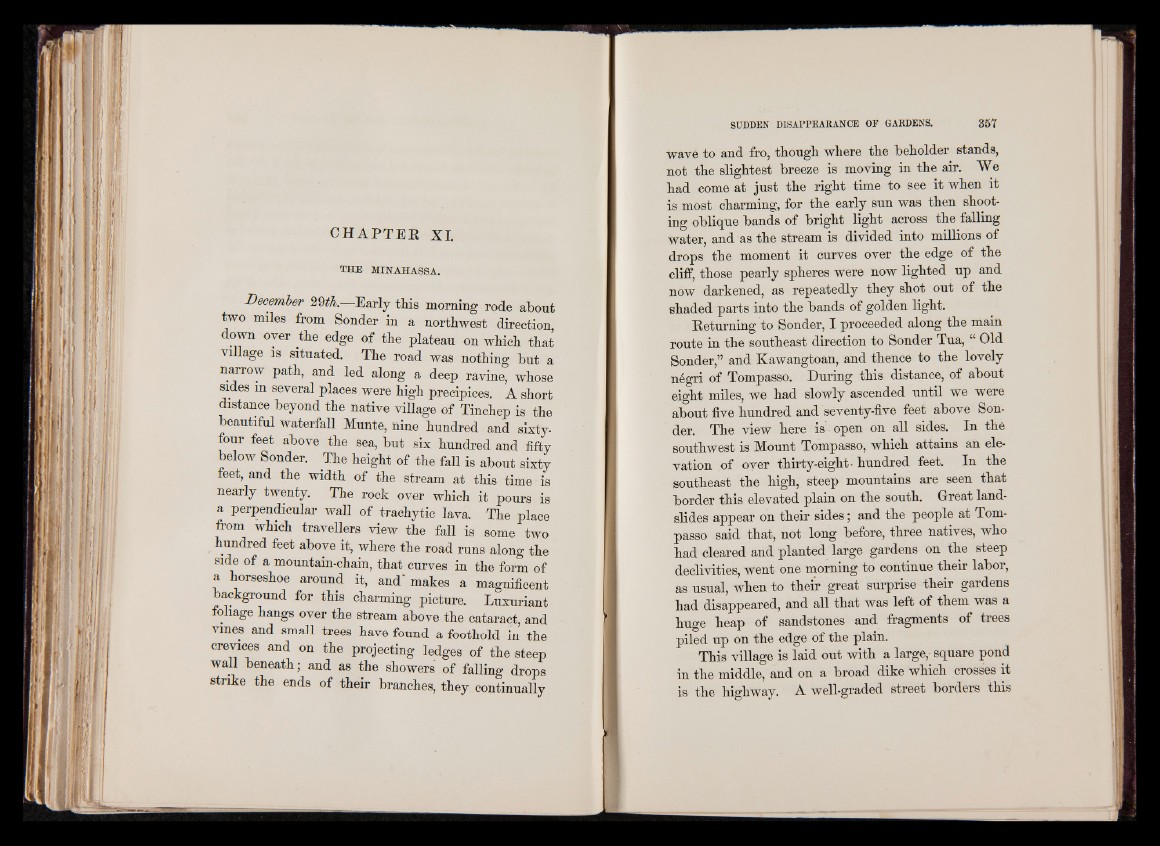
C H A P T E R XI.
THE MINAHASSA.
December 2%th.—Early this morning rode albout
two miles from Sonder in a northwest direction
down oyer the edge of the plateau on which that
village is situated. The road was nothing but a
narrow path, and led along a deep ravine, whose
sides in several places were high precipices. A short
distance beyond the native village of Tinchep is the
beautiful waterfall Munte, nine hundred and sixty-
four feet above the sea, but six hundred and fifty
below Sonder. The height of the fall is about sixty
feet, and the width of the stream at this time is
nearly twenty. The rock over which it pours is
a perpendicular wall of trachytic lava. The place
from which travellers view the fall is some two
hundred feet above it, where the road runs along the
side of a mountain-chain, that curves in the form of
a horseshoe around it, and'makes a magnificent
background for this charming picture. Luxuriant
foliage hangs over the stream above the cataract, and
vines and small trees have found a foothold in the
crevices and on the projecting ledges of the steep
wall beneath; and as the showers of falling drops
strike the ends of their branches, they continually
wave to and fro, though where the beholder stands,
not the slightest breeze is moving in the air. We
had come at just the right time to see it when it
is most charming, for the early sun was then shooting
oblique bands of bright light across the falling
water, and as the stream is divided into millions of
drops the moment it curves over the edge of the
nil i f f , those pearly spheres were now lighted up and
now darkened, as repeatedly they shot out of the
shaded parts into the bands of golden light.
Returning to Sonder, I proceeded along the main
route in the southeast direction to Sonder Tua, # Old
Sonder,” and Kawangtoan, and thence to the lovely
négri of Tompasso. During this distance, of about
eight miles, we had slowly ascended until we were
about five hundred and seventy-five feet above Sonder.
The view here is open on all sides. In the
southwest is Mount Tompasso, which attains an elevation
of oyer thirty-eight- hundred feet. In the
southeast the high, steep mountains are seen that
border this elevated plain on the south. Great landslides
appear on their sides ; and the people at Tompasso
said that, not long before, three natives, who
had cleared and planted large gardens on the steep
declivities, went one morning to continue their labor,
as usual, when to their great surprise their gardens
had disappeared, and all that was left of them was a
huge heap of sandstones and fragments of trees
piled up on the edge of the plain.
This village is laid out with a large,- square pond
in the middle, and on a broad dike which crosses it
is the highway. A well-graded street borders this